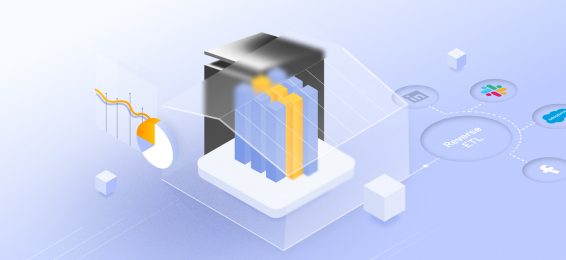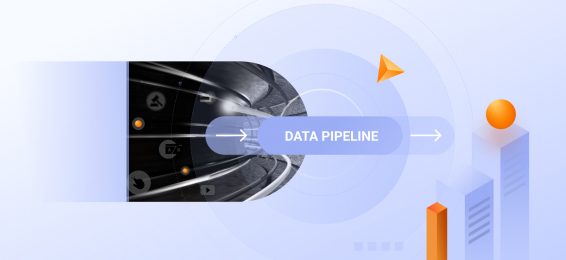Data is the backbone of enterprise infrastructure.
New tools allow marketing and customer success teams to collect more insight on user preferences, interactions, and critical touchpoints.
Managing, processing, and extracting value from these data volumes is pivotal, especially as companies shift to AI-based workflow automation that hinges on high-quality training data.
Scalable, cost-effective data pipelines have become a critical enabler of automation, personalization, and long-term competitiveness. And the impact is measurable:
- Switching data storage providers helped AMN Healthcare slash storage costs by 95%.
- Integrating big data analytics into the data pipeline helped Walmart increase its online sales by 10-15%.
- Rolls-Royce and IFS built an automated data pipeline, which improved data accuracy and reduced the time needed to share data.
Tweaking data pipeline performance and infrastructure costs starts with understanding the key components of a high-performance data pipeline and the technical decisions engineering teams make with each step of data processing.
This guide walks through the core components of a high-performance data pipeline, backed by real-world use cases and technical decision points your team should consider.
What is a data pipeline?
A data pipeline makes raw data, server logs, sensor readings, or transaction history usable for analysis, reporting, or storage.
To understand how data moves through each step, let’s examine a pipeline a retailer could use to collect, process, and apply customer data to plan marketing campaigns and improve retention.
Step 1. Ingestion: Collecting sales transactions from POS (point-of-sale systems).
Step 2. Transformation: Cleaning the data and merging it with inventory records
Step 3. Loading: Loading the processed data into a cloud-based warehouse
Step 4. Application: Querying customer data for modeling a marketing campaign
This is an effective but simplified way to conceptualize the components of a typical enterprise data pipeline.
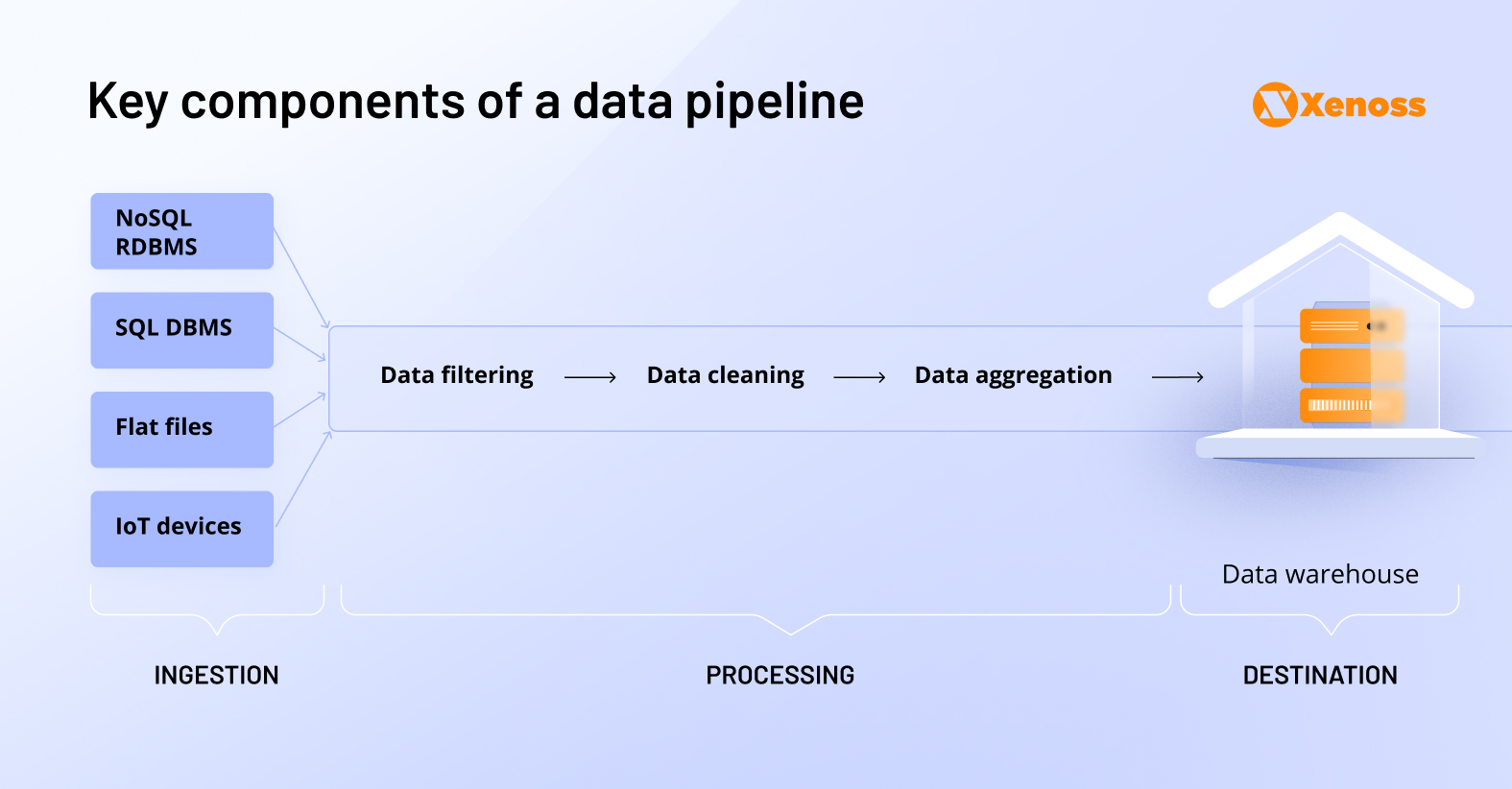
Key components of a data pipeline
In practice, modern data pipelines use more building blocks to manage input data effectively, often in different formats (CSV, JSON, XML, Parquet, among others) from several sources.
Let’s break down the key data pipeline components.
Data sources
Data pipelines process inputs from different kinds of sources: Relational and NoSQL databases, data warehouses, APIs, file systems, or third-party platforms (e.g., social media).
If a pipeline ingests data from multiple sources, discrepancies between types (structured and unstructured), formats, and data parameters from each point of origin are likely.
To ensure consistent data flow across the pipeline, data engineers use source selection and standardization techniques, such as reliability scoring, relevance filtering, schema enforcement, normalization, and many more.
A “good” source should also score high across data quality dimensions:
- Accuracy: Data correctly represents the real-world value or event.
- Completeness: All required data is present with no missing values.
- Consistency: Data is uniform across different systems or datasets.
- Timeliness: Data is up-to-date and available when needed.
- Validity: Data conforms to defined formats, rules, or standards.
- Uniqueness: No duplicates exist; each record is distinct.
- Integrity: Relationships among data elements are correctly maintained.
Data ingestion
Data ingestion is the process of moving data from its source into the pipeline. It can happen in two primary ways: batch processing and stream processing.
Batch processing
Batch processing processes chunks, aka batches, of data at set intervals. This method is applied to engineer pipelines in projects that do not require critical real-time processing.
For example, an insurance enterprise can use batch processing to identify suspicious claims or classify incidents by severity. This method enables ingesting large data volumes from claim records and the book of policies.
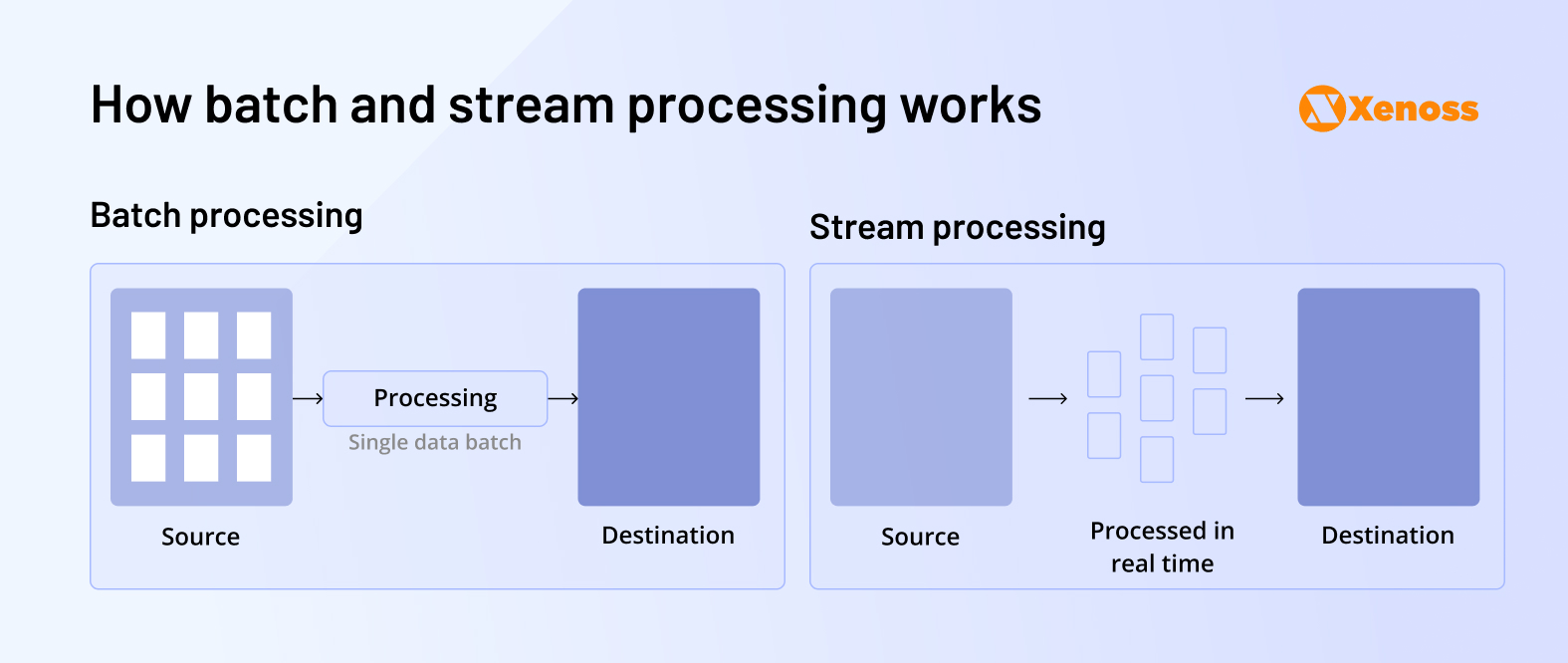
Stream processing
Stream processing is an ingestion technique that enables real-time data processing. It is typically used for real-time finance analytics, media recommendation engines, and traffic monitoring.
Nationwide Building Society, the leading retail bank in the United Kingdom, created a real-time data pipeline to reduce back-end system load, comply with regulations, and handle increasing transaction volumes.
The data engineering team used Apache Kafka, Change Data Capture, Confluent Platform, and Microservices to support the under-the-hood architecture.
Data processing
Once in the system, the data gets validated, cleansed, and enriched. At the processing stage, data engineers confirm the accuracy of inputs, filter out incorrect data, and check format consistency across data points.
Data transformation
At this stage, raw data needs to be transformed into a unified structure and format to become usable across systems. Transformation ensures consistency, simplifies querying, and enables cross-platform analysis.
This step is especially critical when consolidating data from disparate sources with different schemas or structures.
Here are a few industry-specific examples of data transformation.
- Business intelligence: Raw data is aggregated, filtered, and shaped into structured dashboards and reporting views.
- Machine learning: Data is encoded, normalized, and structured to train models effectively and improve prediction accuracy.
- Cloud migration: Moving from on-premise systems to cloud lakehouses like Snowflake and Databricks often requires format conversion, field mapping, and restructuring for compatibility.
Whether for analytics, modeling, or storage, transformation makes raw data analysis-ready.
Data storage
Once transformed, unified data needs to be stored in a destination system—typically a data lake, data warehouse, or operational database—depending on the use case.
There is no cookie-cutter approach to choosing the right data storage platform: the best approach depends on many variables.
- The purpose of the data (analytics, machine learning, real-time processing).
- The type and structure of ingested data.
- Processing throughput requirements. High-load AdTech data pipelines, for example, have to process hundreds of thousands of queries per second.
- The geographic scale of data distribution.
- Additional performance, governance, or integration needs.
Xenoss engineers find it helpful to break data storage selection requirements into “functional” and “non-functional”.
Functional requirements define what a system should do, including the specific behaviors, operations, and features it must support to fulfill business needs.
| Functional requirements |
| Size – How large are the entities to store? – Will the entities be stored in a single document or split across different tables or collections? |
| Format: What type of data is the organization storing? |
| Structure: Do you plan on partitioning your data? |
| Data relationships – What relationships do data items have: One-to-one vs one-to-many? – Are relationships meaningful for interpreting the data your organization is storing? Does the data you are storing require enrichment from third-party datasets? |
| Concurrency – What concurrency mechanism will the organization use to upload and synchronize data? – Does the pipeline support optimistic concurrency controls? |
| Data lifecycle – Do you manage write-once, read-many data? – Can the data be moved to cold or cool storage? |
| Need for specific features: Does the organization need specific features like indexing, full-text search, schema validation, or others? |
Non-functional requirements describe how a system should perform, focusing on attributes like performance, scalability, reliability, and usability rather than specific behaviors.
| Non-functional requirements |
| Performance – Define data performance requirements. – What data ingestion and processing rates are you expecting? – What is your target response time for data querying and aggregation? |
| Scalability – How large a scale does your organization expect the data store to match? – Are your workloads rather read-heavy or write-heavy? |
| Reliability – What level of fault tolerance does the data pipeline require? – What backup and data recovery capabilities does the organization envision? |
| Replication – Will your organization’s data be distributed across multiple regions? – What data replication features are you envisioning for the data pipeline? |
| Limits: Explore the limits of data stores to ensure they do not hinder the scalability and throughput of your data pipeline. |
Data orchestration
Data orchestration helps organizations manage data by organizing it into a framework that all domain teams who need the data can access.
Orchestration connects all these sources in a data pipeline that a retailer uses to collect customer orders from its website, warehouse inventory data, and shipping updates from delivery partners. It pulls the order data, checks inventory in real time, updates shipping status, and sends everything to a central dashboard.
This way, a retailer can track the entire customer journey without manually stitching together data from different systems.
Leading enterprise organizations like Walmart introduced similar orchestration workflows to create real-time connections between data points.
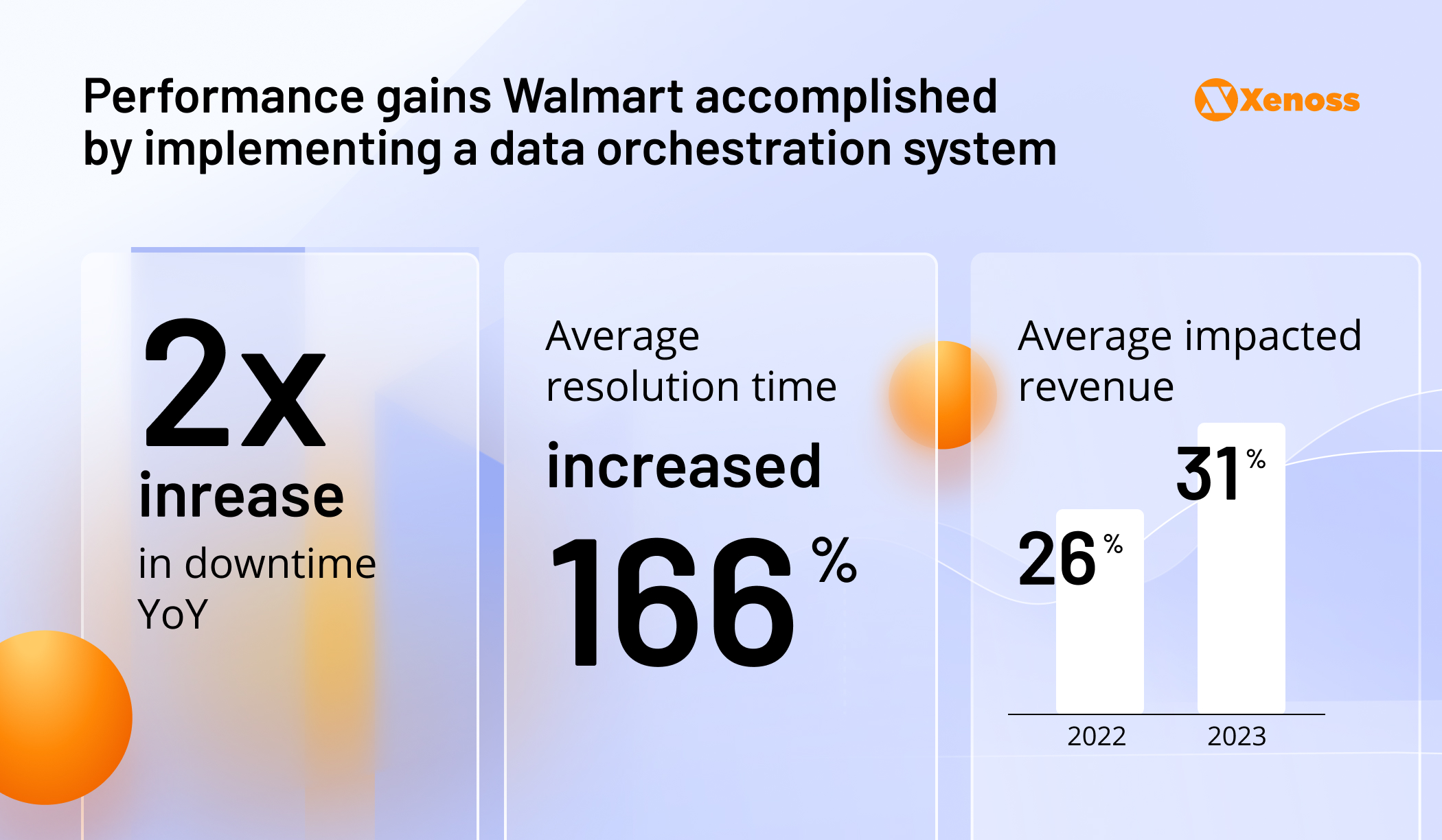
In finance, JP Morgan implemented an end-to-end data orchestration solution that supports investors with accurate and continuous insights. The platform uses association and common identifiers to link data points and ensure interoperability.
Whether coordinating batch jobs, triggering real-time updates, or syncing systems across departments, orchestration is what turns raw data movement into reliable, automated workflows.
Monitoring and logging
An enterprise data pipeline should be monitored 24/7 to detect abnormalities and reduce downtime.
A log list captures a detailed record of events across the pipeline, covering ingestion, transformation, storage, and output. These logs are essential for root cause analysis during incidents, auditing pipeline activity, debugging, and optimizing pipeline performance.
Together, monitoring and logging form the operational backbone of observability—helping engineering teams maintain data integrity, meet SLAs, and resolve issues before they escalate.
Security and compliance
Data-driven organizations should implement privacy-preserving practices, like end-to-end sensitive data encryption or access control, to build pipelines that comply with privacy laws (GDPR, California Privacy Protection Act) and industry-specific legislation.
A focus on compliance is particularly relevant to finance and healthcare organizations that store sensitive data. For instance, Citibank partnered with Snowflake, leveraging the vendor’s data sharing and granular permission control to reduce the risk of privacy fallouts.
Bottom line
Well-architected data pipelines help enterprise organizations connect all data sources and extract maximum value from the insights they collect.
Designing a scalable, high-performing, and secure data pipeline to support enterprise-specific use cases requires technical skills and domain knowledge.
Xenoss data engineers have a proven track record of building enterprise data engineering and AI solutions. We deliver scalable real-time data pipelines for advertising, marketing, finance, healthcare, and manufacturing industry leaders.
Contact Xenoss engineers to learn how tailored data engineering expertise can streamline internal workflows and improve operations at your enterprise organization.
